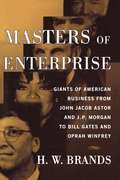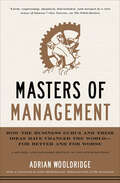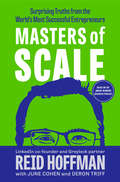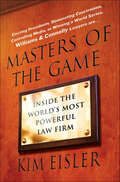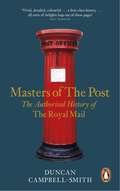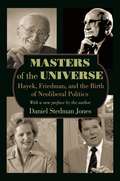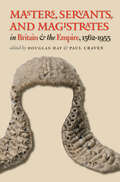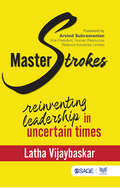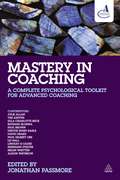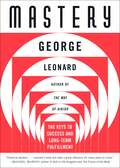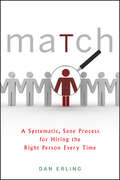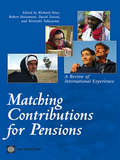- Table View
- List View
Masters of Enterprise
by H. W. BrandsFrom the early years of fur trading to today's Silicon Valley empires, America has proved to be an extraordinarily fertile land for the creation of enormous fortunes. Each generation has produced one or two phenomenally successful leaders, often in new industries that caught contemporaries by surprise, and each of these new fortunes reconfirmed the power of fanatically single-minded visionaries. John Jacob Astor and Cornelius Vanderbilt were the first American moguls; John D. Rockefeller, Andrew Carnegie, and J. P. Morgan were kingpins of the Gilded Age; David Sarnoff, Walt Disney, Ray Kroc, and Sam Walton were masters of mass culture. Today Oprah Winfrey, Andy Grove, and Bill Gates are giants of the Information Age. America has again and again been the land of dizzying mountains of wealth. Here, in a wittily told and deeply insightful history, is a complete set of portraits of America's greatest generators of wealth. Only such a collective study allows us to appreciate what makes the great entrepreneurs really tick. As H. W. Brands shows, these men and women are driven, they are focused, they deeply identify with the businesses they create, and they possess the charisma necessary to persuade other talented people to join them. They do it partly for the money, but mostly for the thrill of creation. The stories told here -- including how Nike got its start as a business-school project for Phil Knight; how Robert Woodruff almost refused to take control of Coca-Cola to spite his father; how Thomas Watson saved himself from prison by rescuing Dayton, Ohio, from a flood; how Jay Gould nearly cornered the gold market; how H. L. Hunt went from gambling at cards to gambling with oil leases -- make for a narrative that is always lively and revealing and often astonishing. An observer in 1850, studying John Jacob Astor, would not have predicted the rise of Henry Ford and the auto industry. Nor would a student of Ford in 1950 have anticipated the takeoff of direct marketing that made Mary Kay Ash a trusted guide for millions of American women. Full of surprising insights, written with H. W. Brands's trademark flair, the stories in Masters of Enterprise are must reading for all students of American business history.
Masters of Enterprise: Giants of American Business from John Jacob Astor and J. P. Morgan to Bill Gates and Oprah Winfrey
by H. W. BrandsFrom the early years of fur trading to today's Silicon Valley empires, America has proved to be an extraordinarily fertile land for the creation of enormous fortunes. Each generation has produced one or two phenomenally successful leaders, often in new industries that caught contemporaries by surprise, and each of these new fortunes reconfirmed the power of fanatically single-minded visionaries. John Jacob Astor and Cornelius Vanderbilt were the first American moguls; John D. Rockefeller, Andrew Carnegie, and J. P. Morgan were kingpins of the Gilded Age; David Sarnoff, Walt Disney, Ray Kroc, and Sam Walton were masters of mass culture. Today Oprah Winfrey, Andy Grove, and Bill Gates are giants of the Information Age. America has again and again been the land of dizzying mountains of wealth. Here, in a wittily told and deeply insightful history, is a complete set of portraits of America's greatest generators of wealth. Only such a collective study allows us to appreciate what makes the great entrepreneurs really tick. As H. W. Brands shows, these men and women are driven, they are focused, they deeply identify with the businesses they create, and they possess the charisma necessary to persuade other talented people to join them. They do it partly for the money, but mostly for the thrill of creation. The stories told here -- including how Nike got its start as a business-school project for Phil Knight; how Robert Woodruff almost refused to take control of Coca-Cola to spite his father; how Thomas Watson saved himself from prison by rescuing Dayton, Ohio, from a flood; how Jay Gould nearly cornered the gold market; how H. L. Hunt went from gambling at cards to gambling with oil leases -- make for a narrative that is always lively and revealing and often astonishing. An observer in 1850, studying John Jacob Astor, would not have predicted the rise of Henry Ford and the auto industry. Nor would a student of Ford in 1950 have anticipated the takeoff of direct marketing that made Mary Kay Ash a trusted guide for millions of American women. Full of surprising insights, written with H. W. Brands's trademark flair, the stories in Masters of Enterprise are must reading for all students of American business history.
Masters of Management: How the Business Gurus and Their Ideas Have Changed the World—for Better and for Worse
by Adrian WooldridgeIn 1996, having completed a two-year research study, longtime Economist journalists and editors John Micklethwait and Adrian Wooldridge published The Witch Doctors, an explosive critique of management theory and its legions of evangelists and followers. The book became a bestseller, widely praised by reviewers and devoured by readers confused by the buzzwords and concepts the management “industry” creates. At the time, ideas about “reengineering,” “the search for excellence,” “quality,” and “chaos” both energized and haunted the world of business, just as “the long tail,” “black swans,” “the tipping point,” “the war for talent,” and “corporate responsibility” do today.For decades, since the rise of MBA programs on campuses across the country, the field of management has operated in a dubious space. Many of its framers clamor for respect within the academy while making millions of dollars pedaling ideas, some brilliant and some nonsensical, in speeches, consulting arrangements, and books.Although The Witch Doctors was a damning critique (“a scalpel job,” according to the Wall Street Journal), it also argued that much of management theory is valuable—making companies more effi-cient and productive, improving organizational life for workers, and providing sound ways for companies to innovate while defending more entrenched plans. Building upon all that made the original such a phenomenal success, this fully revised and updated edition, Masters of Management, takes into account the rise of the Internet, the growing power of emerging markets, the Great Recession of 2008, and the more recent developments in management theory. The result is an indispensable volume for any manager.
Masters of Scale: Surprising Truths from the World's Most Successful Entrepreneurs
by Reid HoffmanWhat can you learn from a Silicon Valley legend and a pantheon of iconic leaders? The key to scaling a successful business isn&’t talent, network, or strategy. It&’s an entrepreneurial mindset—and that mindset can be cultivated.&“If you&’re scaling a company—or if you just love a well-told story—this is a book to savor.&”—Robert Iger, #1 New York Times bestselling author of The Ride of a LifetimeBehind the scenes in Silicon Valley, Reid Hoffman (founder of LinkedIn, investor at Greylock) is a sought-after adviser to heads of companies and heads of state. On each episode of his podcast, Masters of Scale, he sits down with a guest from an all-star list of visionary founders and leaders, digging into the surprising strategies that power their company&’s growth. In this book, he draws on their most riveting, revealing stories—as well as his own experience as a founder and investor—to distill the secrets behind the most extraordinary success stories of our times.Here, Hoffman teams up with Masters of Scale&’s executive producers to offer a rare window into the entrepreneurial mind, sharing hard-won wisdom from leaders of iconic companies (including Apple, Nike, Netflix, Spotify, Starbucks, Google, Instagram, and Microsoft) as well as the bold, disruptive startups (such as 23andMe, TaskRabbit, Black List, and Walker & Co.) that are solving the problems of the twenty-first century.Through vivid storytelling and incisive analysis, Masters of Scale distills their collective insights into a set of counterintuitive principles that anyone can use. How do you find a winning idea and turn it into a scalable venture? What can you learn from a &“squirmy no&”? When should you stop listening to your customers? Which fires should you put out right away, and which should you let burn? And can you really make money while making the world a better place? (Answer: Yes. But you have to keep your profits and values aligned.)Based on more than a hundred interviews and including a wealth of new material never aired on the podcast, this unique insider&’s guide will inspire you to reimagine how you do business today.
Masters of the Game: Inside the World's Most Powerful Law Firm
by Kim EislerA veteran legal reporter reveals the inner workings of Washington’s most powerful law firm with “vivid, savvy reportage” (Kirkus Reviews).For decades, journalist Kim Eisler has covered the law firm of Williams & Connolly as its partners have risen to key positions in American politics, business, and culture. From presidential impeachments to professional sports teams, from the Iran-Contra scandal to the rise of Sarah Palin, Williams & Connolly has been behind the scenes. Now, with her deep knowledge and unprecedented access to its partners, Eisler reveals how Williams & Connolly has attained such power and influence.Eisler begins with the firm’s founder, Edward Bennett Williams, who often said he was building not just a law firm but a monument. Masters of the Game shows how his disciples carried his philosophy and practices beyond Washington to dominate business, media, finance, sports and the American psyche itself.
Masters of the Post: The Authorized History of the Royal Mail
by Duncan Campbell-SmithThe origins of the Post Office go back to the early years of the Tudor monarchy: Brian Tuke, a former King's Bailiff in Sandwich, was acknowledged as the first 'Master of the Posts' by Cardinal Wolsey in 1512, and went on to build up a network of 'postmasters' across England for Henry VIII. Over the following five hundred years the Royal Mail expanded to an unimaginable degree to become the largest employer in the country, and the face of the British state for most people in their everyday lives. But it also faced the demands of an increasingly commercial marketplace. With the election of Margaret Thatcher in 1979, the possibility of privatising the Royal Mail has prompted passionate arguments - and has added immeasurably to the difficulties of running it. In charting the whole of this extraordinary story, Duncan Campbell-Smith recounts a series of remarkable tales, including how postal engineers built the first programmable computer for the wartime code-breakers of Bletchley Park and how the Royal Mail managed to successfully continue delivering post to the front lines during two world wars, but also how they failed to avert the Great Train Robbery of 1963. He brings to life many of the dominant personalities in the Royal Mail's history - from Rowland Hill, who imposed a uniform penny post and set the great Victorian expansion on its way, to Tony Benn who championed the modernisation of the service in the 1960s and Tom Jackson who led the postal workers' biggest union through fifteen frequently stormy years up to 1982. This is the first complete history of the Royal Mail up to the present day, based on its comprehensive archives, and including the first detailed account of the past half-century of Britain's postal history, made possible by privileged access to confidential records. Today's debate over the future of the Royal Mail is shown to be just the ;atest chapter in a centuries-old conflict between its roles raising revenue and serving the public. Will its employees remain, like Brian Tuke's postmasters, servants of the Crown? This book could hardly appear at a more timely moment.
Masters of the Universe, Slaves of the Market
by Stephen BellStephen Bell and Andrew Hindmoor compare banking systems in the U.S. and UK to those of Canada and Australia and explain why the system imploded in the former but not the latter. Canadian and Australian banks were able to make profits through traditional lending practices, unlike their competition-driven, risk-taking U.S. and UK counterparts.
Masters of the Universe: Hayek, Friedman, and the Birth of Neoliberal Politics - Updated Edition
by Daniel Stedman JonesHow radical free-market ideas achieved mainstream dominance in postwar America and BritainBased on archival research and interviews with leading participants in the movement, Masters of the Universe traces the ascendancy of neoliberalism from the academy of interwar Europe to supremacy under Reagan and Thatcher and in the decades since. Daniel Stedman Jones argues that there was nothing inevitable about the victory of free-market politics. Far from being the story of the simple triumph of right-wing ideas, the neoliberal breakthrough was contingent on the economic crises of the 1970s and the acceptance of the need for new policies by the political left. This edition includes a new foreword in which the author addresses the relationship between intellectual history and the history of politics and policy.Fascinating, important, and timely, this is a book for anyone who wants to understand the history behind the Anglo-American love affair with the free market, as well as the origins of the current economic crisis.
Masters, Servants, and Magistrates in Britain and the Empire, 1562-1955
by Paul Craven Douglas HayMaster and servant acts, the cornerstone of English employment law for more than four hundred years, gave largely unsupervised, inferior magistrates wide discretion over employment relations, including the power to whip, fine, and imprison men, women, and children for breach of private contracts with their employers. The English model was adopted, modified, and reinvented in more than a thousand colonial statutes and ordinances regulating the recruitment, retention, and discipline of workers in shops, mines, and factories; on farms, in forests, and on plantations; and at sea. This collection presents the first integrated comparative account of employment law, its enforcement, and its importance throughout the British Empire. Sweeping in its geographic and temporal scope, this volume tests the relationship between enacted law and enforced law in varied settings, with different social and racial structures, different economies, and different constitutional relationships to Britain. Investigations of the enforcement of master and servant law in England, the British Caribbean, India, Africa, Hong Kong, Canada, Australia, and colonial America shed new light on the nature of law and legal institutions, the role of inferior courts in compelling performance, and the definition of "free labor" within a multiracial empire.Contributors:David M. Anderson, St. Antony's College, OxfordMichael Anderson, London School of EconomicsJerry Bannister, Dalhousie University, Nova ScotiaM. K. Banton, National Archives of the United Kingdom, LondonMartin Chanock, La Trobe University, AustraliaPaul Craven, York UniversityJuanita De Barros, McMaster UniversityChristopher Frank, University of ManitobaDouglas Hay, York UniversityPrabhu P. Mohapatra, Delhi University, IndiaChristopher Munn, University of Hong KongMichael Quinlan, University of New South WalesRichard Rathbone, University of Wales, AberystwythChristopher Tomlins, American Bar Foundation, ChicagoMary Turner, London University
Masters, Slaves, and Exchange
by Kathleen M. HilliardThis book examines the political economy of the master-slave relationship viewed through the lens of consumption and market exchange. What did it mean when human chattel bought commodities, 'stole' property, or gave and received gifts? Forgotten exchanges, this study argues, measured the deepest questions of worth and value, shaping an enduring struggle for power between slaves and masters. The slaves' internal economy focused intense paternalist negotiation on a ground where categories of exchange - provision, gift, contraband, and commodity - were in constant flux. At once binding and alienating, these ties endured constant moral stresses and material manipulation by masters and slaves alike, galvanizing conflict and engendering complex new social relations on and off the plantation.
Masterstrokes: Re-inventing Leadership in Uncertain Times
by Latha VijaybaskarThis book helps to answer two important questions—What does it mean to be a leader today and in the future and how can you be the hero of your story and lead in a way that best harnesses the incredible potential of your generation? This book is for leaders whose decision-making challenges increase as the unknowns multiply. Masterstrokes paves the way to script your leadership narrative, to lead the changing followership, to race towards uncertainty and to create innovative solutions needed to succeed in the surplus economy. Masterstrokes catalyzes personal transformation and positive leadership through a research backed seven-step model, STROKES, to empower leaders to lead in uncertain times when they are dealing with a rising gig economy, shorter delivery cycles and flatter organizations.
Mastery in Coaching
by Jonathan PassmoreThe reasons that coaching works so well and can produce such dramatic results are grounded in psychology, so it follows that some of the most powerful coaching methods available draw on psychological thinking. This up-to-the-minute guide presents the latest thinking on the most effective techniques coaches can use with their clients. Every chapter is written by a leading expert in the field, and takes a rigorous, evidence-based approach which will give you a practical understanding of each method, supported with examples, and underpinned by the theory of the key psychological concepts in coaching. Ranging from cognitive-behavioural coaching, gestalt and positive psychology to neuroscience and mindfulness, this indispensable book will give any serious coach the tools they need to get the best from their clients.
Mastery in Coaching: A Complete Psychological Toolkit for Advanced Coaching
by Jonathan PassmoreThe reasons that coaching works so well and can produce such dramatic results are grounded in psychology, so it follows that some of the most powerful coaching methods available draw on psychological thinking. Published with the Association for Coaching, Mastery in Coaching presents the latest thinking on the most effective techniques coaches can use with their clients. Every chapter is written by a leading expert in the field, and takes a rigorous, evidence-based approach which will give you a practical understanding of each method, supported with examples, and underpinned by the theory of the key psychological concepts in coaching. Ranging from cognitive-behavioural coaching, gestalt and positive psychology to neuroscience and mindfulness, this indispensable book will give any serious coach the tools they need to get the best from their clients.
Mastery: The Keys to Success and Long-Term Fulfillment
by George Leonard"The practical wisdom in George Leonard's book will have a great influence for many years to come."—Michael Murphy, author of Golf in the Kingdom and The Future of the BodyDrawing on Zen philosophy and his expertise in the martial art of aikido, bestselling author Gorge Leonard shows how the process of mastery can help us attain a higher level of excellence and a deeper sense of satisfaction and fulfillment in our daily lives. Whether you're seeking to improve your career or your intimate relationships, increase self-esteem or create harmony within yourself, this inspiring prescriptive guide will help you master anything you choose and achive success in all areas of your life.In Mastery, you'll discover: • The 5 Essential Keys to Mastery • Tools for Mastery • How to Master Your Athletic Potential • The 3 Personality Types That Are Obstacles to Mastery • How to Avoid Pitfalls Along the Path. . . and more
Mat MacGregor (A)
by Chin B. Ho Vijay V. SatheMat MacGregor took charge of a failing project but failed to turn it around because of a variety of personal, technical, cultural, and political reasons. The purpose of the case is to understand the underlying dynamics and their implications.
Mat MacGregor (B)
by Chin B. Ho Vijay V. SatheDescribes how Mat MacGregor dealt with issues raised at the end of the (A) case.
Match
by Dan ErlingHire the right person-every time! Why is it that so many companies accept mediocre hiring results as the norm? The answer is simple. It doesn't occur to them that, in fact, there is a process that virtually guarantees hiring the right person every time. To repeat: there is a process that virtually guarantees hiring the right person every time. That's what MATCH is about. Based on author Dan Erling's experience with best practices from over a thousand companies, MATCH gives you a rock solid, practical process for hiring. MATCH takes you step-by-step through the lifecycle of hiring, from developing a job description through interviewing and making the decision, to negotiating salary and onboarding the new hire Applicable tools, stories, and foolproof techniques are woven throughout to insure your mission critical objective is accomplished The author is well-known in the hiring and recruiting industry With MATCH, your hiring team will develop a systematic process that fits with the company's overall mission, giving your company the people it needs to succeed every time!
Match Next: Next Generation Middle School?
by Daniel Goldberg John J-H KimThis case is set in 2015 as a team at Match Education, a high performing charter middle school in Boston, explores new staffing and technology approaches in their quest to obtain what they term "jaw dropping" results. The team hopes to test and model for other schools solutions to specific educational problems. In 2013, the team began to think about the redesign to create a school model in which students spend significantly more time reading, more individualized attention is provided to students and families, the challenge of finding outstanding teachers is addressed, and to do so in a cost-effective manner. In their redesigned school, Match Next, students receive all of their instruction from inexperienced newly minted college graduates called tutors, who are supervised by one master teacher, called a Director of Curriculum of Instruction (DCI). In addition, the Match Next team infuses technology into instruction (e.g. students watch instructional videos and complete online activities) and operations (e.g. schools keeps track of student assessment results and select activities and problem sets from online databases). After the first year as a full-day program, results on the state test were very strong in math but below expectations in ELA (English Language Arts). The case explores questions related to designing the school model, interpreting early results, and assessing the team's ability to disseminate their model to other schools.
Match Next: Next Generation Middle School?
by Daniel Goldberg John Jong-Hyun KimThis case is set in 2015 as a team at Match Education, a high performing charter middle school in Boston, explores new staffing and technology approaches in their quest to obtain what they term "jaw dropping" results. The team hopes to test and model for other schools solutions to specific educational problems. In 2013, the team began to think about the redesign to create a school model in which students spend significantly more time reading, more individualized attention is provided to students and families, the challenge of finding outstanding teachers is addressed, and to do so in a cost-effective manner. In their redesigned school, Match Next, students receive all of their instruction from inexperienced newly minted college graduates called tutors, who are supervised by one master teacher, called a Director of Curriculum of Instruction (DCI). In addition, the Match Next team infuses technology into instruction (e.g. students watch instructional videos and complete online activities) and operations (e.g. schools keeps track of student assessment results and select activities and problem sets from online databases). After the first year as a full-day program, results on the state test were very strong in math but below expectations in ELA (English Language Arts). The case explores questions related to designing the school model, interpreting early results, and assessing the team's ability to disseminate their model to other schools.
Match Next: Next Generation Middle School?
by Daniel Goldberg John Jong-Hyun KimThis case is set in 2015 as a team at Match Education, a high performing charter middle school in Boston, explores new staffing and technology approaches in their quest to obtain what they term "jaw dropping" results. The team hopes to test and model for other schools solutions to specific educational problems. In 2013, the team began to think about the redesign to create a school model in which students spend significantly more time reading, more individualized attention is provided to students and families, the challenge of finding outstanding teachers is addressed, and to do so in a cost-effective manner. In their redesigned school, Match Next, students receive all of their instruction from inexperienced newly minted college graduates called tutors, who are supervised by one master teacher, called a Director of Curriculum of Instruction (DCI). In addition, the Match Next team infuses technology into instruction (e.g. students watch instructional videos and complete online activities) and operations (e.g. schools keeps track of student assessment results and select activities and problem sets from online databases). After the first year as a full-day program, results on the state test were very strong in math but below expectations in ELA (English Language Arts). The case explores questions related to designing the school model, interpreting early results, and assessing the team's ability to disseminate their model to other schools.
Match the Size of the Organization to the Size of the Market
by Clayton M. ChristensenMaximize the opportunity of new technologies and avoid sapping critical resources by over committing in a new direction. This chapter notes that it makes sense to implant projects aimed at commercializing disruptive technologies in small organizations that will view the projects as being on their critical path to growth and success rather than as distractions from the main business of the company. This chapter was originally published as chapter 6 of "The Innovator's Dilemma: When New Technologies Cause Great Firms to Fail."
Match-Fixing in Sport: Comparative Studies from Australia, Japan, Korea and Beyond (Routledge Research in Sport and Corruption)
by Stacey Steele Hayden OpieMatch-fixing represents a greater potential threat to the integrity of sport than doping. It has been linked to organised crime, illegal drugs and money-laundering. Law enforcement and sporting authorities are struggling to establish legal and regulatory responses to this emerging threat, particularly in light of cross-border internet gambling. This book examines match-fixing and the legal responses to it in three key Asian sporting nations: Australia, Japan and Korea. It explores the significance of legal, regulatory and cultural differences, and draws lessons in terms of best practice and enforcement for legal and sporting authorities around the world. Including key insights from players, the betting industry, law enforcement and prosecution authorities, it discusses the strengths and weakness of current anti-corruption strategies in the three jurisdictions. Match-Fixing in Sport: Comparative Studies from Australia, Japan, Korea and Beyond offers important insights for all students and scholars with an interest in sport studies, law, criminology and Asian studies.
Matching Contributions for Pensions
by Richard Hinz Robert Holzmann David Tuesta Noriyuki TakayamaThe use of matching contributions to enhance the participation and level of savings in pensions system has now been in use for nearly three decades in a number of high income countries. Increasingly, countries across the full range of economic development are looking to the design as a means of addressing the low rates of participation in formal pension and other retirement savings systems. A number of countries have recently introduced innovations in their pension systems that significantly rely on contributions matches and related types of direct subsidies to provide incentives for groups that mandates and other indirect methods such as preferential tax treatment have been unsuccessful in reaching. There is particular interest among developing countries in utilizing this design to extend coverage to informal sector and low income workers that typically do not pay income related taxes. This volume provides descriptions and analysis of the design, experience and outcomes achieved in the high income countries where there information about the dynamics and outcomes that this approach has achieved is not beginning to emerge. It also reviews new efforts to use the design in a number of other settings in which the matching contributions have been included as a significant element in reform of the pension system. The review of the experience with matching contribution across this full range of settings provides important observations and some initial lessons for policy makers and analysts who may be considering or evaluating the use of this approach to increase pension coverage.
Matching Dell
by Michael E. Porter Jan W. RivkinAfter years of success with its vaunted "Direct Model" for computer manufacturing, marketing, and distribution, Dell Computer Corp. faces efforts by competitors to match its strategy. The case 'Matching Dell' describes the evolution of the personal computer industry, Dell's strategy, and efforts by Compaq, IBM, Hewlett-Packard, and Gateway 2000 to capture the benefits of Dell's approach. Students are called on to formulate strategic plans of action for Dell and its various rivals.
